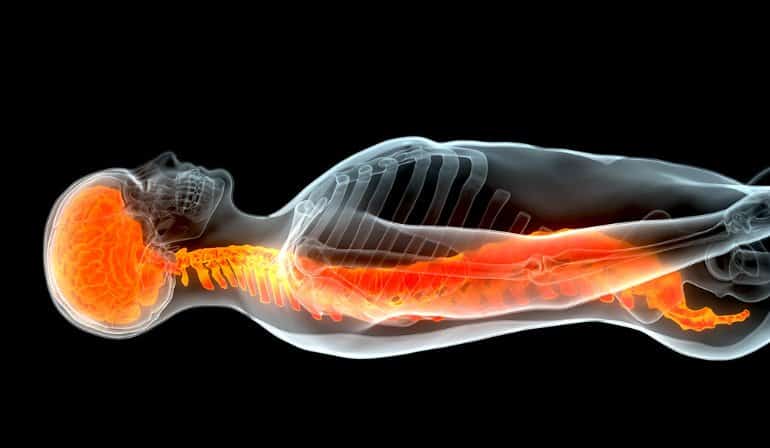Summary: Injecting a patient’s own bone marrow derived stem cells significantly improved motor function within weeks in those with spinal cord injuries.
Source: Yale
Intravenous injection of bone marrow derived stem cells (MSCs) in patients with spinal cord injuries led to significant improvement in motor functions, researchers from Yale University and Japan report Feb. 18 in the Journal of Clinical Neurology and Neurosurgery.
For more than half of the patients, substantial improvements in key functions — such as ability to walk, or to use their hands — were observed within weeks of stem cell injection, the researchers report. No substantial side effects were reported.
The patients had sustained, non-penetrating spinal cord injuries, in many cases from falls or minor trauma, several weeks prior to implantation of the stem cells. Their symptoms involved loss of motor function and coordination, sensory loss, as well as bowel and bladder dysfunction. The stem cells were prepared from the patients’ own bone marrow, via a culture protocol that took a few weeks in a specialized cell processing center. The cells were injected intravenously in this series, with each patient serving as their own control. Results were not blinded and there were no placebo controls.
Yale scientists Jeffery D. Kocsis, professor of neurology and neuroscience, and Stephen G. Waxman, professor of neurology, neuroscience and pharmacology, were senior authors of the study, which was carried out with investigators at Sapporo Medical University in Japan. Key investigators of the Sapporo team, Osamu Honmou and Masanori Sasaki, both hold adjunct professor positions in neurology at Yale.

Kocsis and Waxman stress that additional studies will be needed to confirm the results of this preliminary, unblinded trial. They also stress that this could take years. Despite the challenges, they remain optimistic.
“Similar results with stem cells in patients with stroke increases our confidence that this approach may be clinically useful,” noted Kocsis. “This clinical study is the culmination of extensive preclinical laboratory work using MSCs between Yale and Sapporo colleagues over many years.”
“The idea that we may be able to restore function after injury to the brain and spinal cord using the patient’s own stem cells has intrigued us for years,” Waxman said. “Now we have a hint, in humans, that it may be possible.”
About this spinal cord injury and genetics research news
Source: Yale
Contact: Lakshmi Bangalore – Yale
Image: The image is credited to Yale
Original Research: Open access.
“Intravenous Infusion of Auto Serum-expanded Autologous Mesenchymal Stem Cells in Spinal Cord Injury Patients: 13 Case Series” by Kocsis et al. Clinical Neurology and Neurosurgery
Abstract
Intravenous Infusion of Auto Serum-expanded Autologous Mesenchymal Stem Cells in Spinal Cord Injury Patients: 13 Case Series
Background
Although spinal cord injury (SCI) is a major cause of disability, current therapeutic options remain limited. Recent progress in cellular therapy with mesenchymal stem cells (MSCs) has provided improved function in animal models of SCI. We investigated the safety and feasibility of intravenous infusion of MSCs for SCI patients and assessed functional status after MSC infusion.
Methods
In this phase 2 study of intravenous infusion of autologous MSCs cultured in auto-serum, a single infusion of MSCs under Good Manufacturing Practice (GMP) production was delivered in 13 SCI patients. In addition to assessing feasibility and safety, neurological function was assessed using the American Spinal Injury Association Impairment Scale (ASIA), International Standards for Neurological and Functional Classification of Spinal Cord (ISCSCI-92). Ability of daily living was assessed using Spinal Cord Independence Measure (SCIM-III). The study protocol was based on advice provided by the Pharmaceuticals and Medical Devices Agency in Japan. The trial was registered with the Japan Medical Association (JMA-IIA00154).
Results
No serious adverse events were associated with MSC injection. There was neurologic improvement based on ASIA grade in 12 of the 13 patients at six months post-MSC infusion. Five of six patients classified as ASIA A prior to MSC infusion improved to ASIA B (3/6) or ASIA C (2/6), two ASIA B patients improved to ASIA C (1/2) or ASIA D (1/2), five ASIA C patients improved and reached a functional status of ASIA D (5/5). Notably, improvement from ASIA C to ASIA D was observed one day following MSC infusion for all five patients. Assessment of both ISCSCI-92, SCIM-III also demonstrated functional improvements at six months after MSC infusion, compared to the scores prior to MSC infusion in all patients.
Conclusion
While we emphasize that this study was unblinded, and does not exclude placebo effects or a contribution of endogenous recovery or observer bias, our observations provide evidence supporting the feasibility, safety and functional improvements of infused MSCs into patients with SCI.







